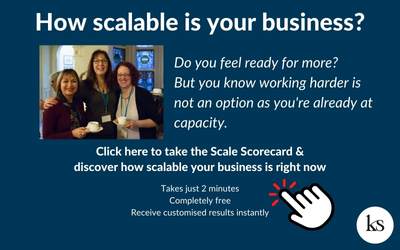
by Karen Skidmore | 01,23 | Product Strategy
How strategic are you being about what you sell to your clients?
When you are struggling to attract enough reliable and predictable business, it can mean you do your best to stay flexible and open for any new work. It can feel that by offering a big menu of services, quoting for bespoke work, and creating lots of online courses or workshops, you are offering the right things to the right people at the right time.
But the reality is that you may be spreading yourself too thin, often with clients on lots of different price points, and making your business more complicated and harder than it needs to be.
Many years ago, I used to create something new several times a year. I was more in love with the creation process than I was with digging into the sales strategy of my business, and when I wasn’t creating new things to sell, I would be either promoting or delivering, and consequently bounced from product launch to the next. This not only meant my business was very transactional and price sensitive, it also meant that I was working too hard for the results I was getting, and this way of working contributed greatly to my peri-meno health crisis in my 40’s.
So I know your pain if you’ve ended up with a business with clients on different price points and a huge list of products or programmes you’ve created over the years. It can feel messy and that you are out of control of your business. But you are not alone! Not being strategic about the products and services you offer is one of the huge opportunities for growth that we often miss.
And when we get it right, the results can be huge.
Sell the products and services that truly meet the needs of your clients at the right stage of their journey with you, and you’ll see an increase in conversions, a boost in client loyalty, and more consistent and predictable revenue.
Let me explain and share what goes in my business today.
Today, I have a core product – some may call this a signature programme – called Momentum, a one year business growth programme. It’s a brilliant programme but I know that the time and money investment means that it’s rare that someone would buy this on impulse. I also know I am one of many thousands of business coaches out there, so someone has to have a level of trust in me, as well as get to know my style and what I stand for. I simply can’t sell this, expecting everyone to say yes the first time they discover me.
So alongside Momentum, we also have Ignite, a one day business growth workshop that I have been running for several years. It’s a low risk purchase, whilst still giving high value, and also allows someone to experience me and my team.
Plus I now have Leap, a brand new 28-day business accelerator, designed to give you the clarity and roadmap you need to build a better run, more rewarding business. Again, it’s a lower risk purchase than Momentum, but higher than Ignite, and meets people where they are at, i.e. needing help with their sales and reducing the stress levels in how they run their businesses.
But here’s the thing; both these lower risk purchases have been designed to be pre-cursors to Momentum; people don’t have to buy Momentum if they attend Ignite or Leap, but if they want to continue to work with me and my team, it’s a natural progression. So the job of both these products is not necessarily to be big revenue generators, but to help give solutions to my clients before they feel ready to commit to Momentum.
How do you apply this to your business? Now, of course, my product strategy is not a cookie cutter solution and I wouldn’t expect it to work for you without knowing what goals you have and the market place you work in. But the principles of working out an efficient and effective flow to your products and services are the same.
To get you started in your thinking, here are three practical steps you can take to make sure you’re selling the right products to the right people at the right time:
1) Know your target market
This may seem obvious, but the real difference you can make here is knowing the journey of your ideal client; mapping out what your client needs at the different stages of the problem you can solve for them. The better you understand this journey, the more effective you’ll be able to start a relationship with them and for them to become a longer term client who buys from you again and again.
2) Develop your core product or service and be on a mission to make it as good as you can
If something is working, don’t distract yourself with new, shiny ideas. Get feedback, make your product or service better, go deeper with the results that you get for your clients and develop the systems to enable you to deliver this product or service as simply and easily as possible.This will also enable you to keep your core product relevant and adapt as your clients’ needs may evolve over time, plus it gives your client a simple, yet effective menu to choose from.
3) Back engineer new product ideas from your core product
Diversify too quickly or end up bespoking your core product for too many clients, and you are going to spread yourself too thin again. I get that you may like to be creative in your business and you enjoy doing new things, but don’t let this be to the detriment of your goals and the business success you want. So before you get excited about a new way of working with your clients, sanity check the idea against the journey of your ideal client; are you meeting them where they are at, or is your creativity distracting you.
If you are interested in knowing more and deep diving into what the right product strategy is for you and your business, then I invite you to check out my business accelerator program. It’s designed specifically to help business owners like you grow their businesses in a smart and sustainable way, and our second module is all about simplifying your sales and what you sell to your clients.
Plus it’s a great opportunity to work with me, an experienced business coach and mentor, who can make sure you are on the right track, especially when there are so many distractions out there with regards to product creation and new ideas!
If you’re ready to take your business to the next level, I encourage you to check out the programme and see if it’s the right fit for you. Click the link here to learn more and book your place.
Until next time,


by Karen Skidmore | 10,22 | Product Strategy
There are many good reasons to offer a payment plan to your customers, but there are also a lot of assumptions that many business owners make about how they go about offering them, particularly whether they ought to be charging their clients more for taking up the payment plan option.
In this article, I want to debunk some myths and misconceptions, and help you see how positioning your payment plans can actually benefit both you and your clients.
Don’t see payment plans as recurring income
I know many business owners like to have a consistent flow of income, but to see payment plans as recurring income will actually cheat your sales mindset.
A payment plan is accepting payment for a one-off product or service; once sold, you are delivering it for a specific finite time.
Recurring income has a completely different job to do as it’s revenue from a product or service that a client continues to use each month or year, with no specific finite time until the client decides to stop buying.
Many years ago, I used to feel safer knowing that I had money coming in each month and thus was very happy for a client to take up a payment plan, but what this would do would let me off the hook of selling more over the coming months. I would make myself feel more comfortable than I actually was and would even stop selling when I saw a healthy chunk of money coming to me over the next few months. The reality was that I was spreading the money out, rather than growing the business revenue.
Don’t charge your clients more for taking a payment plan
Yes, I get the argument that it can cost the business when payment plans are defaulted or card payments don’t work, especially if you are dealing with hundreds or even thousands payment plans.
But if you know that there is always a percentage of card payments that need sorting each month, then see this is a cost to your business, in the same way your web hosting and internet usage is. Either look at how you can improve your business processes to automate as much as possible, or factor this into your overall prices.
Plus there are certain laws and regulations you need to be aware of.
In the UK, The Consumer Rights (Payment Surcharges) Regulations 2012 is now in place which made it unlawful for “merchants from charging a fee in addition to the advertised price of a transaction on the basis of a consumer’s choice of payment instrument (for example, credit card, debit card or e-money)”.
 I asked Suzanne Dibble, founder of the Small Business Legal Academy and my go-to legal advisor for her advice on the matter.
I asked Suzanne Dibble, founder of the Small Business Legal Academy and my go-to legal advisor for her advice on the matter.
“Payment plans or instalment agreements could fall foul of Consumer Credit legislation if more than 12 instalments are charged or interest (or any other fee) is charged. It has been suggested that if offering payment plans to consumers (which includes sole traders and partnerships), you express the instalment price as the full price and discount the price for pay in full, so as to be able to argue that no interest or other fees have been charged for the instalment credit. However there is no guidance that this rather artificial way of structuring things would keep you safe.”
If you are based outside of the UK, do check your own country’s regulations in regards to payment plans.
Do see payment plans as a good way of helping your clients
Your clients should never feel shamed into taking the payment plan option. If they want to choose to spread their payments over a period of time, there is often a genuine reason for it.
They may not have the money right here, right now, so don’t shame them for not having the cash. Let them make their own decisions over payments depending on their circumstances.
They may not trust you enough to pay up front and that’s OK, too. Trust is always earnt before it is given, so if your new client wants to start to see results before they are willing to commit to paying everything up front, then start giveing them the results that you are promising.
If you are attracting the kind of clients who take up payment plans as a try-before-you-buy, ie they cancel in the first month or two, and you are getting financially burnt in the process, then you have to take a hard look at your client attraction process and eligibility, as well as the quality of your product.
Perhaps you are either willing to accept anyone as a client or that you are over-promising on your product offer.
Do reward your clients for paying in full
If you can’t charge more for your payment plan option, then flip this around and reward those who want to pay upfront. I would also advise that you would want to have your clients pay you upfront if it’s possible; better to have the money in your bank, than theirs as it saves on invoice chasing at best and debt collection at worst.
Plus I like to think that when you have the money up front, it puts you in a position where you have to deliver. They’ve put their trust in you so make sure you not only give them the goods, but exceed their expectations.
You can reward them with a simple discount, although don’t be too generous! 10% may sound like a nice figure, but if you haven’t factored this discount into your overall revenue goals, you could find yourself short. Do your sums and factor any discounts into your price structure so you can achieve your sales targets.
If you don’t want to discount, or the margins are already too tight to discount further, then you can reward them by giving them access to a lower priced digital product, discount code for partner products or services (a great way of forging client referrals and recommendation with other businesses) or some other gift that does not take your time or additional costs.
Do let your clients make the decision which option they take
It would be easy to now decide that you want all your clients to take the full payment, but going heavy with the sales to persuade them to say no to the payment plan may mean you lose the sale completely.
We have a saying in our Momentum community; be committed but not attached to the outcome. Make your offer, talk through the options available but stay unattached to what your client decides. People love to buy, but often hate being sold to so think about how you position your offer so that your client feels they genuinely have the choice, rather than being bullied into it.
Do write about your payment plan options in your marketing campaigns
If you are launching a product online or running a marketing campaign, deciding when you talk about the payment plan option presents some great reasons for people to click your emails or check out your sales page.
Write about your payment plan options somewhere in your email campaign, and explain the benefits of taking advantage of it.
A technique that I have seen many big internet marketers use is to bring in another payment plan that is spread over a longer period of time at the last minute – just before the shopping cart closes – which brings the risk down and helps those people who are still sitting on the fence to say yes to the offer. (Do make sure you’ve read the advice from Suzanne above about extending payment plans for longer than 12 months.)
Do offer payment plans when your client can no longer pay their invoices
We are heading towards difficult times for some and the cost of living is on the increase. You may find more clients have agreed to buy something from you but then over a period of weeks may not be able to pay you for whatever reason.
Collecting money owed for work already delivered, or part delivered, can be a horrid and difficult process for both parties, but communication is key. So rather than write off outstanding invoices or threaten legal proceedings too early, talk about spreading payments over a longer period of time. If you do go down this route, have the conversation face to face – zoom or phone – rather than rely on emails and ensure everything is documented and agreed, with clear payment terms and invoicing dates confirmed with both parties to avoid any further disputes.
In summary, view your payment plan options as both a sales and marketing opportunity to help more clients buy your products or services, as well as a way of offering good customer service. Set yourself and your clients up for success, rather than penalise them for taking the payment option.
Ready to discover how well you are set up to attract more rewarding and better paid work?
Answer 21 yes/no questions based on your current business activities that will show you what you may be missing and what to focus on to get your next stage of growth.

by Karen Skidmore | 10,22 | True Profit
If you run a busy business, it’s easy to feel responsibility for not only getting new leads and winning over new clients, but also for delivering the work and all the admin tasks that go along with that.
For most business owners I speak with, having a business operate without them being in the thick of everything, all the time can seem an impossibility.
So is it really possible for your business to operate twelve months of the year, whilst you take holidays, weekends away or even finish your work day at 3pm if that is what you want?
However much fire fighting you feel you are doing right now, I want to reassure you that yes, you can absolutely achieve this.
It isn’t something that can happen overnight but over the course of the next few months, you can start to shift yourself from being a busy freelancer to being a CEO of your business.
Step One – Your CEO Mindset
Start the transition from being the person who does it all, to being a business leader.
This starts with recognising your role as a freelancer (the part of you who does the delivery), your role as a business owner (the part of you who is responsible for the running of the business – sales, marketing, operations, finances) and your role as a CEO (the part of you who strategically plans long term and focuses on your next stage of growth).
This important first step helps you move away from ‘winging it and hoping for the best’ because when you are busy, busy, busy it’s no surprise that you can’t think or visualise what your bigger dreams are and where you could hope for your business to be in 5 years time.
You need to slow yourself down so you can clear the mental overload in your brain, and give you the space to clarify your professional and life goals and ambitions.
Have a read of my article next where I dive in to the problem of having an overloaded brain and the time impact it has your ability to long term plan.
Step Two – Get operational support
If you are running everything yourself, with maybe the odd bit of outsourcing of design work or ad hoc admin, then the first action to take is almost always to hire someone to help with your business operations.
If you have a virtual assistant working for you already, it may be time to review their role and assess whether you are ready to hire operations manager level support so that someone else takes on the day to day running of the business for you.
You need to free up some time so you can work ON your business, rather than IN it every day. Breaking this ‘do it all yourself’ habit, no matter what experiences you have had in the past, is essential if you want to be able to take time out of the business for holidays and shorter work weeks and days.
Don’t just hire anyone; it’s important that you write out a job description – what it is you feel you need help with and what kind of person you feel would bring out the best in you. If you don’t know where to start, then have a read of my how to hire an operations manager article.
Step Three – Get a grip of your finances
My version of profitability is not just the potential of your financial gain, but also how well your business model is set to ensure your business delivers the best results to your clients, with the time and energy you want to give.
If you haven’t done much work on your finances over the past few years except to sign off your tax return and company accounts, a deep dive into your finances to help you benchmark and track the numbers in your business is needed and this will help you make better decisions about where to focus.
Decisions such as:
- Are your prices right? Is the price you are charging not only giving you the income you want but also going to give you the cash flow to invest in your sales, marketing, systems & processes to support your delivery?
- Can you afford to outsource? Have you factored in your costs so you make sure you still get paid?
- When and where do you invest your time, energy, and resources? Where are your future profit opportunities, and when would be the right time to diversify or work with different audiences?
- Which products to stop offering and clients to ‘sack’? Are you really making ‘enough’ sales to justify your efforts?
- Can you invest in advertising? Are your sales going to give you the right return on investment?
Without taking a good look at your finances, you may be missing an easier or simpler route for your next stage of your growth.
And even if you have exceptional support from your accountant, this kind of financial work is rarely done because your statutory tax return and end of your accounts don’t give you the right financial information to help you spot your profitability and growth potential in your business.
Step Four – Review your products and service offerings
How easy it is to reach and take on more clients, and increase your revenue and impact without you having to work harder and more hours to get there will depend on what it is you are selling.
If you are already maxed out on either time, energy or client work, the objective at this stage of your business is not to focus more of your time on marketing and attracting more clients, but to assess how well your products are supporting your business goals.
The more personal and bespoke your offers are, the harder it is for you to scale your business; if you don’t have a standard process or framework to take your clients through, you will always be limited to what you can personally deliver.
And, in my experience, no matter how individual you think your service is, there are always repeatable lessons and teachings that can be created and turned into digital content, even if you aren’t interested in creating group programmes or online courses.
Start by clarifying the specific results your clients get from working with you, then map out the exact steps you take to give them these results.
Plus it may be time to review how much of your time is spent delivering during the week.
Even if you still feel you are the only one who has the expertise, is there someone who could take on a client support role? i.e. host q&a sessions, take on the initial assessment and onboarding, or even accountability follow up sessions depending on the programme or service you currently offer. This is great first step if you are feel nervous or unsure how outsourcing work will work for you and your clients.
Step Five – Process, process, process
As your business grows, the need for process grows. Process isn’t just for large enterprises; it’s needed at every stage of business growth and size, so it’s critical that you prioritise which processes you need to work on.
There are 4 key areas:
- Operations: everything you need to run your business on a day-to-day basis; from email management and computer backups to monthly finances and renewing insurance.
- Sales & Marketing: you can not rely on word-of-mouth referrals and your inbox to manage your prospecting, so if you haven’t done so already, it’s essential to start putting in the processes in order to generate consistent leads and create sales opportunities.
- Delivery: in order to consistently exceed your clients’ expectations, you need the processes to be able onboard and deliver what it is you’ve promised.
- Team: knowing how to hire (and fire!), as well as how to run your weekly team meetings and quarterly review meetings will ensure managing people doesn’t become the headache that we know many fear it will.
And if this list feels rather overwhelming, go back to the second step, get operational support, as taking action on a lot of these processes is not something you will have to do.
Someone in your team needs to take on some of these process projects so you can keep more of your time free for being CEO, and step away from being freelancer and even business owner (see Step One!).
To sum up …
To sum up, these five steps aren’t something you can do overnight. They usually take between nine and twelve months, whilst still allowing you time to run the business and deliver what your clients want from you.
And yes, there may feel like a lot of work here but I promise you that this kind of work is a lot less hard work than what you are probably doing right now by doing it all yourself.
If you would like help in working through one or more of these steps, a great place to begin is with our Scale Scorecard which will show you how scalable your business is right now.
And you never know, you may have much of this covered already and the report will give you recommended next steps to take.
Plus, you can book yourself on one of our free Scale Clinics to discuss your results with me; these are run twice a month so look out for the link to book your place once you’ve completed the scorecard.


by Karen Skidmore | 09,22 | Business Planning, Midlife & Menopause
Are you an over-thinker? Does your brain only know how to solve short term tactical problems?
One of the biggest barriers to growing my own business over the years hasn’t been because I didn’t have enough clients, or good enough products, or even enough time; it’s because I lacked the mental clarity and the space to think strategically.
Over the past 18 years of running my own coaching and training businesses, I have been working around my family. My children are now 20 and 22, but I won’t forget those crazy school day schedules in a hurry. My head was always full of to-do-lists.
What to cook for dinner, and did I have enough in the fridge or did I have to stop off at the supermarket on the way back from pick-up? What are they going to wear for World Book Day next week? Did they have the right trainers for hockey season? (and why do they need different sports shoes for every different sport FFS?!) … the lists never stopped.
This mental ticking off carried over into my business.
I had trained my brain to think in short term decision making and although this meant I was a very good problem solver, this wasn’t helpful for thinking about my business growth.
I was often knee-jerking from one product launch to the next and I would get bored of a programme or a workshop and want to do something new, even when what I was promoting was working really well, and I spent my week making tactical decisions and reacting to what was coming into my inbox.
And I know I am not alone.
Whether you are a parent or not, this kind of mental overloading happens regularly with service professionals such as trainers, coaches and consultants. Because you are often working directly with clients and you are good at solving their problems, you are giving a lot of your time to each new piece of work or proposal that comes in.
And even if you think you can solve this by trading your time with online products and digital programmes, if you are a natural over-thinker, as well as good at what you do and clients keep buying from you, you will still do a lot of tactical thinking and reacting to everyday problems that keeps your mind focused on the here-and-now.
So how did I shift and create the mental space for strategic thinking so that I could make the time for business planning and spotting the right opportunities for growth.
Firstly, I had to recognise that getting better at time management wasn’t the solution.
If your brain is trained to be solving short term problems and you get a buzz out of a busy delivery week, there’s every chance you will make yourself more efficient at getting stuff done, rather than creating the space needed for strategic thinking.
Secondly, I began to address my working week rhythm’s and flow. To begin with, I couldn’t simply plug in a whole day to take off for business planning; my diary was booked out for weeks and it seemed that I didn’t have the time. The trick I discovered was to block out days out for thinking ‘on’ the business 6 weeks or more in advance, and this has become my go-to advice for everyone since.
Go to the point in your diary when you have spaces in your delivery calendar – and yes this may be two months or more – and block out two or three days. Don’t worry about what you are going to actually do during this time at this point; the important thing is that you carve out the time in advance now so that you have a firebreak in your schedule.
I also addressed how I started my working week. Monday mornings became time for me and the business and this now looks like weekly review of campaigns and implementation plans, team meetings and finances. Again, this acts like a firebreak and I can reset myself, no matter how busy the week before was.
Finally, I needed a process to follow. I knew that if I left strategic thinking time to its own devices and simply went with the flow, I would fill my head with more thoughts and ideas that never had the chance to be executed. I have found techniques such as journaling to be helpful to a point, but I needed a way to structure my ambitions and vision into a way that could be implemented.
And buying beautifully designed planning diaries (and yes, I have most of them on my bookshelf!) rarely helped me because they often over-complicated the process or distracted me by giving me lots of irrelevant boxes to complete.
So over the years, I crafted my own planning process that simplified what was needed to scale my business, and it worked so well that we now teach it in our Momentum business growth programme. The Grow Strong planning process is based on the 90 day planning principles, but rather than have a back-to-back quarterly cycle, I run it three times a year on a trimester basis.
What this does is allow space between the implementation time to review and reflect (as well as catch your breath which, as I got older, I needed so much more of!) and slows the pace down.
And it’s this slowing down that actually speeds up the business growth.
I know it may sound rather counterintuitive, but for a classic over-thinker like myself and for many of our clients in the Momentum community, it’s been instrumental to creating the space for strategic thinking, respecting your health needs as well as being able to behave more like a CEO, rather than someone who runs a busy business.
So where are you at? Are you an over-thinker? Has reading this made you realise that your brain may be trained to solve short term tactical problems, rather than the long term strategy needed to grow your business?
And if you’ve already identified this, what have you done to slow down your tactical thinking and create the time and space for business planning?
Next steps: If you know you want to scale your business but you’re not sure what your next steps are, then an easy first step to take is my Scale Scorecard. You simply answer 21 questions and then my system will make a recommendation based on your responses.
This is a game changer – saves you time, focuses your effort, and gives you clarity all in under 3 minutes. Better still, I’ve made it free for you!
Click here and get your custom recommendations.

by Karen Skidmore | 08,22 | Business Process, Winning Business
It’s not nice, but it happens! No matter how good your selection process is for winning clients, you will find yourself working with someone who you don’t want to work with anymore.
They may not be paying their invoices on time, or they are consistently late to meetings. Or will even on occasion not even show up and not think to message you.
Perhaps they are the ones holding up the project you’ve agreed to work on; you can’t move forward with what you’ve promised to deliver because they or one of their team members haven’t given you what you needed, and it’s mucked up your delivery schedule with your other clients.
And then there are the clients that you’ve been working with for a while, but because of the shifts you are making into new offerings and pricing structure, and you’re spending too much time and energy on the kind of clients you don’t want to work with any more.
Having to fire a client certainly isn’t a sign of success, but recognising that you have a problem with a client is certainly a sign that you are shifting your business and your CEO thinking forwards. And if you don’t do anything about it now, it is going to become an even bigger problem over the coming months.
So how do you go about firing a client? Especially when you’ve probably worked hard to get them and frankly, you could do with the money and maybe not be in a position to refund anyone who may have paid upfront. I get it; it’s not a nice job to have to do.
Over the past 18 years of running my own coaching and training businesses, I’ve fortunately not had to fire many clients. But I remember in the early days how painful it was, and how wrapped up emotionally I was in the whole process. I feel awful letting people down and I simply hate conflict. But over the years, I’ve learnt how to deal with it so that both me and my client come out happy, because when I didn’t deal with it at the time, I let the situation get far trickier than it needed to be.
Here’s my suggestions on how to deal with clients you want to fire.
1. Identify that you have a problem. Say it out loud to yourself and acknowledge that this is a problem you have to sort out. This is an important first step because too often, especially if you are busy, it’s easier to ignore all the signs and you begin to justify the situation and make allowances for your client’s behaviour. As soon as you begin to allow your client to have this power over you, it’s amazing how servient you can become ie doffing the proverbial cap, with a yes sir, no ma’am. When your professional boundaries start to slide like this, it can become very toxic, very quickly, and will have an impact on you are working with your other clients.
2. Review the situation. Before you start ranting and raving about your terrible client, take a step back and review what really may be going on. Have you addressed the fact that your client hasn’t paid on time/been late for meeting/not done their ‘homework’? And what boundaries did you have in place at the start of the working relationship, and how clear did you make these to your client? If you haven’t got clear terms and conditions, contract or service level agreements signed, then you have to take responsibility for not setting the working relationship boundaries clear in the first place. Get this sorted asap so you don’t fall foul of this ever again! If you have, then you have perfect grounds to set a meeting with your client (and I recommend that you do this outside of any agreed paid-for consulting/coaching time), to discuss how certain boundaries have slipped, and how you can both get back on track.
3. Assume the best, always. In my experience, the few clients who I have had to fire over the years were never bad people. Yes, they had bad behaviour but when we discussed what was going on, it was usually as a result of something in their personal life, such as a health crisis or stress levels, or they were struggling with cash flow. Is your client finding it hard to keep with the agreed timeframe because of other work commitments? Have they got a problem at home that is taking their attention? Has their boss given them a different directive that is now clashing with the project you are working on together?
4. Communication is key; and always best done in person. When in doubt, always pick up the phone or arrange a meeting. Don’t try to resolve a problem with a tricky client via email because typed words can be taken in so many ways. And definitely don’t use emojis to try to do this work for you, yes?! So yes, you may not like conflict as I very much don’t, but you can’t hide behind an email because you won’t get to the root of the problem.
5. Maybe you don’t need to fire the client. Which takes me to this important step in the process. When you get to the root of the problem, you may find that addressing this actually deepens your working relationship, and if you can both come to a solution, may ensure you have a brilliant client for life. Of course, have your bull shit radar on 😉 but if you remember step 3, most people aren’t out to screw you over!
6. Keep your decision quick and commercial. If you do decide the best thing is to break your contract (which of course will depend on what is in your contract – see step 2 above!), then stay away from any emotional reasons, and make the decision quickly. Remember there are always two sides to every situation and you don’t want to be caught up in a justification argument ie he said/she said. State the facts, always confirm everything in an email, keep it clean, and refer back to your original contract/service level agreement that was set at the start of the relationship.
7. Do you need to offer a refund if they’ve paid upfront? Again, this decision needs to be taken commercially, not emotionally. If your contract states that no refund is needed, whether you or them cancel the contract, you may still want to review this and give them something (see my next point). I’ve always taken the ‘what’s fair for both of us?’ approach and have even asked the client this question on occasion. You don’t need to justify, but you can lay down exactly what they have received, especially if your project/programme is top heavy and most of the value was at the front end. Sometimes the cleanest thing to do to break the relationship is to give something back, so you can both move on (see my next and final point).
8. Finally, make it a win for your client, too. You don’t need to go above and beyond trying to find a replacement, for example, but they have to feel they have come out of this situation well, too. If they feel hard done by, or are made to feel a bit like a prat or incompetent (especially if you’ve called out their bad behaviour such as being late for meetings), you again run the risk of being caught up in a justification argument, or even worse, have them shame you publicly on social media, which can obviously get very messy. In my experience, the bad behaviour they have demonstrated with you, is often the same bad behaviour they have with other suppliers and team members, so expecting the client to be remorseful or apologise is not something that’s going to happen. Let them win, too and you’ll find it easier to move on and get working with the clients you do love to work with.
One of the big things I teach my clients is how to stay in Power Partnership; the ability to recognise that neither you nor your client are better than each other. Yes, you may well be the expert that they are paying for, but you are both equal powers in the working relationship.
Feeling more powerful than your client, and you will come across as arrogant. Feeling less powerful than your client and you will come across as a people pleaser, doffing that proverbial cap with your yes sir, no ma’am tone.
So if you are reviewing your clients right now and realising that you may have one or two clients you need to fire, step back and ask yourself first where are you in your Power Partnership? Because you can fire a client today, but if you don’t realign your power state, you could be letting in another tricky client as fast you’ve got rid of the last one.
If you want help in putting the right systems and processes in place so that you avoid attracting clients that you have to end up firing, then let’s talk. Book a call with one of our Grow Strong business coaches. There’s never any charge for our first call together. Click here to check out times available.




 I asked Suzanne Dibble, founder of the
I asked Suzanne Dibble, founder of the 








